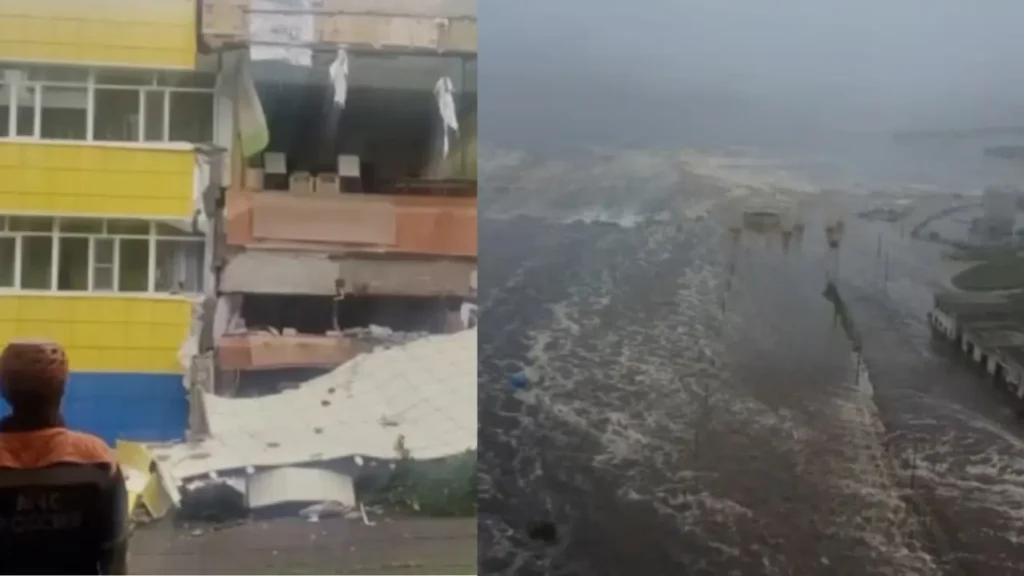New Delhi: On July 30, 2025, a massive earthquake of magnitude 8.8 struck off the coast of Russia’s Kamchatka Peninsula, unleashing a series of tsunami waves that rippled across the Pacific Ocean. The quake, described as the most powerful to hit the region since 1952, prompted widespread tsunami warnings, evacuations, and significant regional impacts, affecting areas as far away as French Polynesia, Japan, Hawaii, and the Galapagos Islands.

Earthquake Details and Immediate Impact
The earthquake, centered 119 km (74 miles) east-southeast of Petropavlovsk-Kamchatsky, a city of 165,000 on the Kamchatka Peninsula, occurred at a shallow depth of 19.3 km (12 miles). According to the U.S. Geological Survey, the quake struck along a megathrust fault, where the denser Pacific Plate slides beneath the lighter North American Plate, a geologically active zone within the Pacific Ring of Fire. This region, known for its active and dormant volcanoes, is highly prone to seismic activity, making Kamchatka particularly vulnerable to such events.
Kamchatka Governor Vladimir Solodov described the quake as “serious and the strongest in decades of tremors” in a video posted on Telegram. Residents in Petropavlovsk-Kamchatsky reported intense shaking that lasted at least three minutes. One local, 25-year-old Yaroslav, recounted, “It felt like the walls could collapse any moment.” Despite the intensity, Kremlin spokesman Dmitry Peskov credited solid building construction and effective alert systems for preventing any casualties in Russia, though several people sustained injuries, none of which were reported as severe.
The quake caused structural damage, with verified reports of a kindergarten in Petropavlovsk-Kamchatsky affected, as shown in footage released by the Russian Ministry for Emergencies. Additionally, the Klyuchevskoy volcano, one of the highest in the world, located 450 km north of Petropavlovsk-Kamchatsky, began erupting shortly after the quake. The Russian Academy of Sciences’ United Geophysical Service reported a “descent of burning hot lava” on the volcano’s western slope, accompanied by explosions and a powerful glow above the crater.
Tsunami Waves and Regional Impacts
The earthquake triggered tsunami waves that impacted multiple regions across the Pacific. In Russia’s Severo-Kurilsk, located in the northern Kuril Islands, waves reached heights of 3 to 5 meters, flooding the port and a fish processing plant, sweeping vessels from their moorings, and submerging the shoreline, including taller buildings and storage facilities. Drone footage verified the extent of the flooding, highlighting the significant disruption caused to this remote town.
In French Polynesia, tsunami waves struck the Marquesas Islands, approximately 1,400 km northeast of Tahiti. Initial surges were reported on Nuku Hiva, the largest island in the archipelago, with local authorities forecasting five to ten additional waves in the hours following the quake. While waves were initially feared to reach 2.5 meters (8 feet), they were smaller than anticipated, and evacuation orders were issued for residents to move to higher ground. Other parts of French Polynesia, consisting of low-lying atolls, experienced wave heights below 30 cm, which did not necessitate evacuations.
Hawaii recorded tsunami waves of up to 1.7 meters, prompting evacuations and temporary suspension of flights from Honolulu airport. By the evening of July 30, 2025, Hawaii downgraded its tsunami warnings, and air travel resumed. In Japan, which was devastated by a 9.0 magnitude earthquake and tsunami in 2011, the eastern seaboard faced evacuation orders for tens of thousands of residents. Tsunami alarms sounded across coastal towns, and the Fukushima nuclear plant, site of the 2011 radioactive disaster, was evacuated as a precaution. Japan recorded waves up to 1.3 meters, but Chief Cabinet Secretary Yoshimasa Hayashi reported no injuries or damage, and no irregularities were detected at nuclear facilities.
Further afield, smaller waves of nearly half a meter reached California, and even smaller waves were observed in Canada’s British Columbia. A tsunami advisory for coastal British Columbia and south Alaska was later canceled. In Ecuador’s Galapagos Islands, 970 km off South America’s coast, authorities ordered precautionary evacuations to safe zones, reflecting the far-reaching impact of the tsunami warnings.
By the evening of July 30, 2025, Russia, Japan, and Hawaii had downgraded or canceled most tsunami alerts, including those for the Kamchatka Peninsula, Sakhalin Island, and Severo-Kurilsk. Russian authorities confirmed that the immediate danger had lessened, though scientists warned that larger aftershocks could not be ruled out due to the ongoing movement of the Pacific Plate.
Understanding Tsunamis: Causes and Characteristics
A tsunami is a series of extremely long waves caused by a large and sudden displacement of the ocean, typically triggered by an earthquake below or near the ocean floor, as seen in this event and the 2004 Indian Ocean Tsunami. Other causes include landslides, volcanic eruptions, glacier calvings, meteorites, and underwater explosions, including nuclear tests. The Pacific Ring of Fire, where this earthquake occurred, is a hotspot for tsunamis due to its high seismic and volcanic activity.
Tsunami waves have unique characteristics. Their speed and wavelength depend primarily on ocean depth rather than the distance from the wave’s source. In the deep ocean, wavelengths can reach approximately 200 km, but near the coast, they reduce to less than 20 km due to shoaling. Wave height, or amplitude, is negligible in deep oceans, often unnoticed by ships, but increases significantly in shallow waters, leading to destructive impacts. In this case, the 3-5 meter waves in Severo-Kurilsk and up to 1.7 meters in Hawaii illustrate this phenomenon.
Consequences of the Earthquake and Tsunami
The socio-economic and environmental consequences of the earthquake and tsunami were significant. In Kamchatka and the Kuril Islands, property damage included flooded infrastructure and affected buildings, such as the kindergarten in Petropavlovsk-Kamchatsky and the submerged port in Severo-Kurilsk. The disruption of essential services, such as port operations and fish processing, impacted local livelihoods. The eruption of Klyuchevskoy volcano added further complexity, with potential risks from lava flows and explosions.
Environmentally, tsunamis can devastate mangroves, coral reefs, and estuaries, while also causing soil and water contamination. These impacts were likely in Severo-Kurilsk, where flooding affected coastal ecosystems. Additionally, the psychological stress on affected communities, coupled with the need for evacuations and recovery efforts, underscored the broader human toll.
NDMA Guidelines for Tsunami Preparedness
The National Disaster Management Authority (NDMA) provides comprehensive guidelines for tsunami preparedness, emphasizing a multi-tiered institutional structure involving the NDMA, State Disaster Management Authorities (SDMAs), and District Disaster Management Authorities (DDMAs). These guidelines focus on enhancing preparedness, mitigation, and emergency response through several key measures:
- Early Warning Systems: Developing robust systems to detect and communicate tsunami risks promptly, as seen in the effective alert systems credited by Russian authorities for preventing casualties.
- Hazard and Vulnerability Assessments: Conducting detailed assessments to identify at-risk areas and populations, enabling targeted mitigation efforts.
- Mitigation Measures: Implementing land-use planning, developing natural buffers such as bio-shields and mangrove regeneration, and protecting critical infrastructure to reduce tsunami impacts.
- Public Awareness and Education: Promoting comprehensive training and awareness campaigns across all stakeholder groups to ensure communities are prepared for such events.
These measures, while not directly referenced in the immediate response to the Kamchatka earthquake, highlight the importance of proactive disaster management, which likely contributed to the relatively low casualty count and efficient evacuations in affected regions.
Global Response and Lessons Learned
The rapid response to the earthquake and tsunami warnings across the Pacific demonstrates the importance of international coordination and advanced warning systems. Japan’s experience with the 2011 tsunami likely informed its swift evacuation protocols, while Hawaii’s quick resumption of air travel reflects effective crisis management. In French Polynesia and the Galapagos Islands, precautionary measures ensured resident safety despite the remote nature of these locations.
The event also underscores the ongoing vulnerability of the Pacific Ring of Fire to seismic activity. The 2004 Indian Ocean Tsunami transformed tsunami science, leading to improved global monitoring and preparedness. This earthquake serves as a reminder of the need for continued investment in disaster resilience, particularly in regions like Kamchatka, where geological activity remains a constant threat.
Conclusion
The magnitude 8.8 earthquake off Russia’s Kamchatka Peninsula on July 30, 2025, and the resulting tsunami waves across the Pacific Ocean highlight the destructive power of natural disasters and the importance of preparedness. From the flooded shores of Severo-Kurilsk to the precautionary evacuations in the Galapagos Islands, the event affected communities thousands of miles apart. While no major casualties were reported, the structural damage, environmental impacts, and volcanic eruption that followed underscore the multifaceted challenges of such events. By adhering to guidelines like those from the NDMA and leveraging global cooperation, affected regions mitigated the worst outcomes, but the event serves as a stark reminder of the need for ongoing vigilance in earthquake-prone areas.
Frequently Asked Questions (FAQs)
1. What caused the tsunami in the Pacific Ocean on July 30, 2025?
The tsunami was triggered by a magnitude 8.8 earthquake off Russia’s Kamchatka Peninsula, which occurred along a megathrust fault where the Pacific Plate slides beneath the North American Plate. This sudden displacement of the ocean floor generated a series of long waves, impacting regions like the Kuril Islands, French Polynesia, Japan, and Hawaii.
2. How severe was the damage caused by the earthquake and tsunami?
The earthquake caused structural damage, including to a kindergarten in Petropavlovsk-Kamchatsky and flooding in Severo-Kurilsk’s port and fish processing plant. No casualties were reported in Russia, but several people were injured. Environmental impacts included potential damage to coastal ecosystems, and the eruption of Klyuchevskoy volcano added further disruption. Tsunami waves reached up to 5 meters in Severo-Kurilsk and 1.7 meters in Hawaii, but no major damage was reported in other regions.
3. Which areas were affected by the tsunami warnings?
Tsunami warnings were issued across the Pacific, including Russia’s Kamchatka Peninsula, Sakhalin Island, and Severo-Kurilsk; Japan’s eastern seaboard; Hawaii; French Polynesia’s Marquesas Islands; Ecuador’s Galapagos Islands; and parts of California and British Columbia. Most warnings were downgraded or canceled by the evening of July 30, 2025.
4. What are the characteristics of tsunami waves?
Tsunami waves have long wavelengths, approximately 200 km in deep oceans, reducing to less than 20 km near coasts due to shoaling. Their amplitude is negligible in deep water, often unnoticed by ships, but increases significantly in shallow waters, causing destructive impacts. Their speed and wavelength depend primarily on ocean depth, not distance from the source.
5. What measures are recommended for tsunami preparedness?
The National Disaster Management Authority (NDMA) guidelines emphasize a multi-tiered structure involving early warning systems, hazard and vulnerability assessments, mitigation measures like land-use planning and mangrove regeneration, and public awareness campaigns. These measures aim to enhance preparedness, reduce risks, and ensure effective emergency responses, as demonstrated by the efficient evacuations and alert systems during this event.

